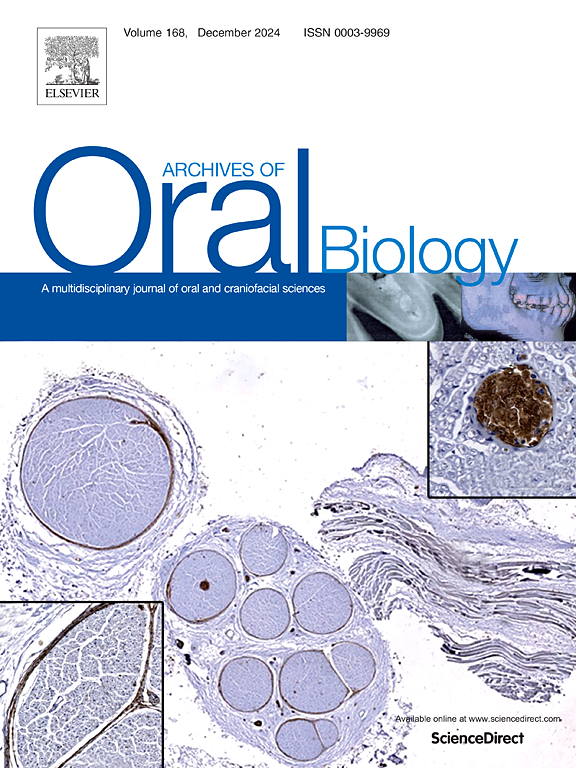维生素 D 血清水平与颞下颌关节紊乱:系统回顾与荟萃分析。
IF 2.2
4区 医学
Q2 DENTISTRY, ORAL SURGERY & MEDICINE
引用次数: 0
摘要
目的:本系统综述评估了维生素 D 血清水平、缺乏症和颞下颌关节紊乱症(TMD)之间的关系,并提供了该领域现有证据的荟萃分析:本系统综述评估了维生素 D 血清水平、缺乏症和颞下颌关节紊乱症(TMD)之间的联系,并对该领域的现有证据进行了荟萃分析:设计:在 Scopus、ISI Web of Science 和 Pubmed 数据库中搜索了有关维生素 D 与 TMD 之间关系的人类研究,其中包括一个对照组。对患有和未患有 TMD 的受试者之间的维生素 D 血清水平平均差 (MD)、维生素 D 缺乏症几率比 (OR) 和风险差 (RD) 采用了带森林图的随机效应模型。根据种族、总体偏倚风险、TMD 诊断方法和研究设计进行了分组分析。P 值低于 0.05 即为显著。根据 GRADE 方法对元证据的确定性进行了评估:在已识别的 2621 条唯一记录中,有 15 项研究被纳入研究,其中 8 项被考虑进行荟萃分析。荟萃分析显示,有 TMD 和没有 TMD 的受试者之间存在显著的维生素 D 缺乏 OR(3.85;95 % CI:2.35 - 5.43;确定性:低)和 RD(22 %;95 % CI:11 % - 32 %;确定性:极低),以及维生素 D 血清水平 MD(-5.03 ng/mL;95 % CI:-9.92 - 0.13;确定性:极低)。在亚组分析中,只有中东和欧洲患者的维生素 D MD 差异显著(P < 0.01):考虑到证据的确定性较低至很低,TMD 患者的维生素 D 血清水平明显较低,维生素 D 缺乏症的发病率明显较高。本文章由计算机程序翻译,如有差异,请以英文原文为准。
Vitamin D serum levels and temporomandibular disorders: A systematic review and meta-analysis
Objective
This systematic review evaluates the connection between vitamin D serum levels, deficiency, and temporomandibular disorders (TMD), offering a meta-analysis of the existing evidence in this domain.
Design
The Scopus, ISI Web of Science, and Pubmed databases were searched for human studies concerning the connection between vitamin D and TMD comprising a control group. A random-effect model with forest plots was used for vitamin D serum levels mean difference (MD), vitamin D deficiency odds ratio (OR), and risk difference (RD) between subjects with and without TMD. Subgroup analysis was conducted based on ethnicity, overall risk of bias, TMD diagnosis method, and study designs. A p-value lower than 0.05 was considered significant. The certainty of the meta-evidence was evaluated according to the GRADE approach.
Results
Of the 2621 identified unique records, 15 studies were included in the study, eight of which were considered for the meta-analysis. The meta-analysis revealed a significant vitamin D deficiency OR (3.85; 95 % CI: 2.35 – 5.43; Certainty: Low) and RD (22 %; 95 % CI: 11 % - 32 %; Certainty: Very low), and vitamin D serum levels MD (-5.03 ng/mL; 95 % CI: −9.92 – −0.13; Certainty: Very low) between subjects with and without TMD. Among subgroup analyses, only the difference in vitamin D MD between Middle Eastern and European patients was significant (P < 0.01).
Conclusion
Considering the low to very low certainty of the evidence, vitamin D serum levels are significantly lower, and vitamin D deficiency is significantly more prevalent in TMD patients.
求助全文
通过发布文献求助,成功后即可免费获取论文全文。
去求助
来源期刊

Archives of oral biology
医学-牙科与口腔外科
CiteScore
5.10
自引率
3.30%
发文量
177
审稿时长
26 days
期刊介绍:
Archives of Oral Biology is an international journal which aims to publish papers of the highest scientific quality in the oral and craniofacial sciences. The journal is particularly interested in research which advances knowledge in the mechanisms of craniofacial development and disease, including:
Cell and molecular biology
Molecular genetics
Immunology
Pathogenesis
Cellular microbiology
Embryology
Syndromology
Forensic dentistry
 求助内容:
求助内容: 应助结果提醒方式:
应助结果提醒方式:


